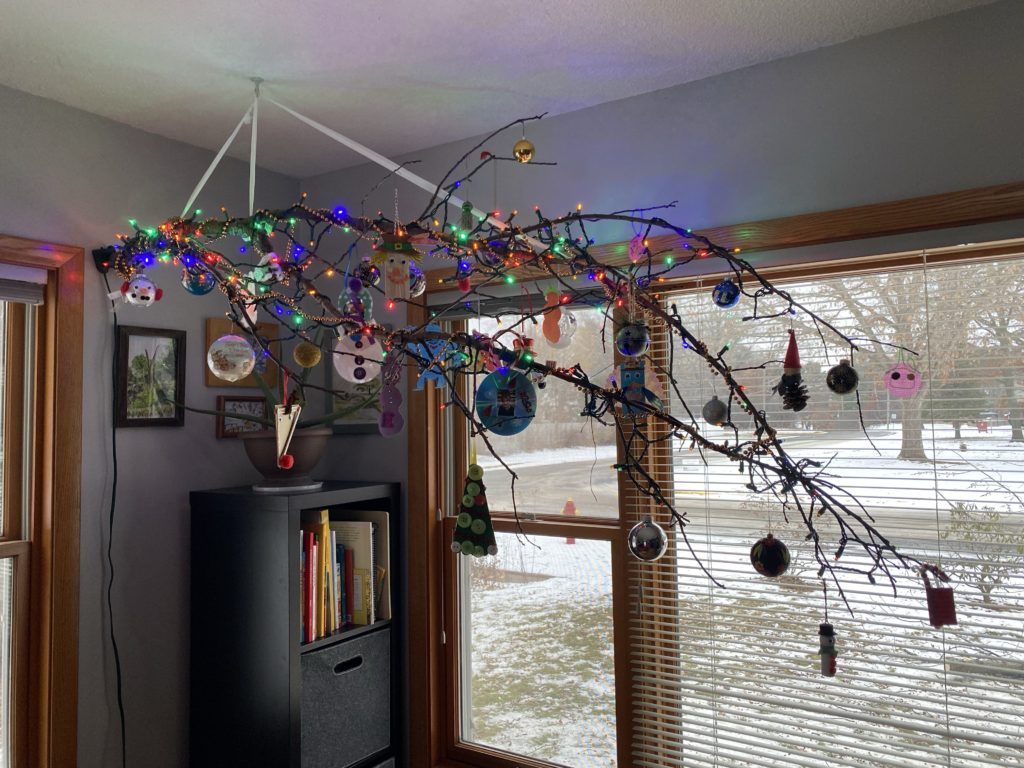“Bah humbug!” That’s my usual response to anything holiday-related. I’ll be the first person to say that the most wonderful time of the year is — quite frankly — not. Over the years my reasons for not wanting to participate in the jolly festivities have varied, but as I’ve gotten older, it’s mainly about the consumption. And one of those consumed items is that darn tree.
A festive pine or coniferous tree can be a lovely addition to any home over the holiday season. However, there are some noteworthy downfalls to this tradition: they can be expensive and environmentally unsound. But there is a more financially reasonable (free!) and eco-friendly option available.

Budget
I know we’re not the only family with a budget. Winter isn’t just an expensive time of year because of gifting. Come December, people get hit with high heating bills, tax payments, requests for donations from their favorite organizations, and then some. In our house, December means car insurance payments and quarterly bills to boot. It’s expensive.
Quite frankly, the last thing I want to drop another $50-$100 on it’s a piece of wood that’s going to be turned into mulch in three weeks’ time.
For many families, a tree (purchasing or renting) is a major financial burden. Even a small, fresh-cut or rented tree can easily cost $50. Many families cherish the time and tradition spent decorating, so they use credit to fund the season. Then they keep their fingers crossed that (at least in the States) it can be repaid by the season’s hopeful bonuses and pending tax refunds.
The Holiday Façade
If you’re sick of my Scroogey spirit, I get it. Most people adamantly fight for their consumptive patterns with claims of deserving it, working hard for it, the “needs” of kids (ie. excessive toys), traditions, yada yada. If that’s you, I’ve probably already lost you. But if you’re still with me? Awesome. Keep reading.
**For the record, I’m not trying to fight the small, local tree businesses. I’m all for them. Historically, the small local tree farm is where we’ve gotten ours, but this year we decided to take a break and try something new.**
Tree waste
Holiday trees — whether plastic or natural — account for a $6.6B industry (2022, finder.com). That’s right, BILLION. Let’s look at our options:
- Locally-sourced, natural trees: These trees have not been treated with chemicals and are not environmentally harmful. The trees that are cut actually do a great service in cleaning the air during their life. However, if the tree is not properly disposed of (chipped and composted), the positives are negated. There’s also the cost of a real, fresh tree which can be incredibly prohibitive for some families.
- Shipped trees: Real trees shipped to areas where pines don’t naturally grow are not as eco-friendly.
- Transportation of these trees takes its toll!
- These trees are also more likely to be treated to make them last longer.
- Areas that don’t naturally grow pines are less likely to offer proper tree disposal services, so refuse is more likely to end up in the landfill.
Due to the transportation costs, these trees can be very cost-prohibitive. They can also go without water for days after being cut, posing a fire hazard.
- Plastic trees: If used for many years, fake trees can be more eco-friendly — and definitely more economical — than real trees. But due to their eventual disposal, they will never make the grade in my book.
- Renting potted trees: This is becoming a more and more popular and accessible option. Tree sizes vary along with their costs, but they’re able to be enjoyed year after year and are able to continue their good work once they’re too large to be rented any longer.
A Budget & Eco-Friendly Tree Option
Last year, as I was scrolling through my Facebook feed, someone posted a beautiful, ambient sight — they called it a troldegren. I’d never heard the phrase before, but they had decorated it in simple, vintage, thrifted ornaments and jewelry from generations past.
The woman who originally posted it also shared a few cultural and historical facts about the piece. Additionally, I reached out to a Finnish acquaintance for more information. Here’s what they had to say:
It’s a Danish tradition.
Troldegren means Christmas branch. (In Finnish it’s jouluoska.)
While the tradition seems to be fading — possibly in favor of full trees — many people still have them.
A troldegren is traditionally from a contorted filbert tree and can last many years. This particular type of branch is sold in floral shops around the winter holiday in Denmark.
Sometimes branches are wired together to create one branch large enough for the space in which it’s hung.
No one was able to find any information about the history of the tradition. My Finnish acquaintance suspected that it had something to do with the Scandinavian tendency toward a more minimal design. (My personal suspicion is that it has to do with a respect of nature or accessibility of trees and adequate space to place them.)
My Finnish acquaintance added their cultural take on jouluoska:
Branches can be used year round and decorated to correspond with the season. (She mentioned one in her young child’s classroom, which they decorate to correspond with the changing seasons.)
The branch doesn’t originate from a particular tree and can be from either a deciduous or coniferous species.
Trying Troldegren
Our family decided to try this tradition this year and the kids and I think it’s lovely! My husband would prefer a full tree (it’s true that you can’t beat that fresh tree smell!), but sees the value in our kids deviating from the norm from time to time. He does, however, appreciate its minimal appearance.

The branch was also very well-received by our holiday guests. No one had seen one before and they all loved its ambience and minimal design. I’ve also decided to adopt the word troldegren, no matter the heritage or tree branch type. But that’s just me. 🙂
Here are a few tidbits about our first holiday branch:
- We found our branch in a brush pile near a local park. We believe it’s a black oak, based on the shape of the leaves that were remaining.
- We hung the branch with some ribbon from an existing hook in our ceiling. It was a bit of a balancing act, but we decided against putting another hook in the ceiling for this experiment.
- We removed all the remaining leaves and cut/broke several branches to keep it within our preferred spatial footprint. Additionally, we bound a few of the branches together using a brown craft string and basic knots.
- Working overhead is rough on the arms! String the lights before hanging.
- A tip on lights: fasten the electrical component to the branch using floral wire or a piece of that.
- Hanging ornaments so high up is a little more challenging for small children. We lost a couple of glass balls to the wood floor. However, I feel like we usually lose at least one in this process, even when working closer to the ground. If we do a troldegren again, we’ll likely cover the ground with a drop cloth first.
- I believe tinsel would have been a lovely addition, but eco-guilt…. Instead we used some beads that we had on hand from years past.

In conclusion, if you’re looking for a good alternate to a pine tree this holiday season — whatever the reason — there is a beautiful, financially accessible, and eco-friendly option available. Troldegren! (Or just Christmas or holiday branch, if you’re not as gung-ho about adopting foreign words into your regular vocabulary as I am.) 🙂
Will you give it a try? How would you decorate yours? Let me know in the comments below!
—Melissa, Funky Crunchy Mama
P.S. My Finnish acquaintance runs a home organization business. Read some of her tips and check out her gamification technique at How to Align Your Ducks.







